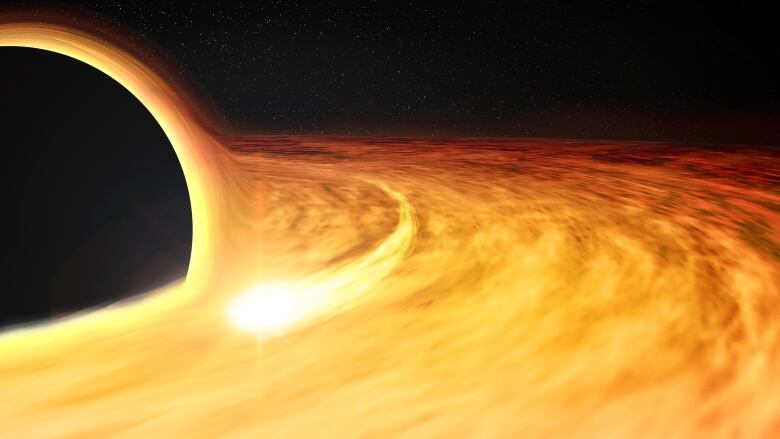Scientists may have detected a black hole devouring a neutron star
'It's really exciting': Colliding objects sent ripple through space-time

First, astronomers made history when they detected a gravitational wave from two black holes merging. Then it was two neutron stars. Now, astronomers believe they've detected a gravitational wave coming from another first-time discovery: a black hole swallowing a neutron star.
Both of these objects — a neutron star and a black hole — are mind-blowing cosmological objects. A neutron star is just the size of a small city but with mass so great that just a teaspoon of its material would weigh 10 million tonnes.
A black hole, on the other hand, is a point in space that isn't made of material at all, but is pure space-time, where, once something crosses its threshold — such as light — it can never escape.
When these two colossal objects meet, something has to give. And in this case, it was the neutron star.
Neutron star or black hole?
Einstein predicted gravitational waves in 1916 in his general theory of relativity. Essentially, he predicted that when two massive objects (in terms of weight) collide or merge, they will produce a ripple much in the same way a rock does when dropped in a pool of water, but throughout space and time.
Finding them, however, would prove difficult. In fact, it took almost 100 years.
The first gravitational wave was detected in 2015 by the Laser Interferometer Gravitational-Wave Observatory (LIGO), which actually consists of two highly sensitive individual instruments located in Livingston, La., and Hanford, Wash.

This new detection was made using LIGO as well as the Virgo laser interferometer in Cascina, Italy. With the data collected thus far, it's believed the wave was triggered by a black hole more than five times the mass of our sun gobbling up a neutron star that was less than three times the mass of our sun.
"It's really exciting because we've never confirmed one of these," said Jess McIver, an assistant professor in the University of British Columbia's department of physics and astronomy who is involved with LIGO.
The caveat is that scientists can't say with 100 per cent certainty that the smaller object was indeed a neutron star. But it's looking good. A recent circular distributed among scientists said they have narrowed down the probability of it being the first neutron star-black hole collision to 99 per cent.
The uncertainty lies in the fact that they can't be sure that the neutron star isn't a black hole itself.
Historically speaking, astrophysicists haven't ever seen a black hole that is less than three solar masses, though that doesn't mean they don't exist.

"We call anything lighter than three solar masses a neutron star,"said Salvatore Vitale, an assistant professor of physics at MIT, who also works with LIGO. "This is a very specific and precise choice."
A collaborative effort
The good thing about having both LIGO and Virgo up and running and scanning the skies for gravitational waves is that, combined, they are able to better localize where the collision or merger occurred. With this recent detection, they've narrowed it to within 23 square degrees — roughly the span of 10 full moons. While it sounds like a large swath of sky, that's actually quite precise when you're talking about these instruments and the faint signals involved.
"For most optical telescopes it's a large area, but for [us], this is like a needle," Vitale said. "It's very, very small to us."
Happening in 'our backyard'
And, Vitale said, in terms of distance, the collision occurred roughly 870 million light-years away.
"By our human standards, this is very far away, but by astrophysical and cosmological scales, this is still our backyard," he said.
But there's another aspect to these gravitational wave detections: sometimes, like in the case of the binary neutron star merger, they can be seen optically.

This possible neutron star-black hole collision hasn't been seen so far in the visible spectrum, but that, too, provides astronomers with valuable data.
"Although we've not seen anything yet, we'll be able to learn a lot about the light we've not seen," said Maria Drout, an assistant professor at the University of Toronto's department of astronomy and astrophysics, who was involved with the optical detection of the binary neutron star merger. "There are some predictions that say you should get light out of systems like this and some that say you shouldn't. So this is this actually very informative."
Now that astronomers have found three distinct types of these mergers — two black holes, two neutron stars and a neutron star and black hole — it might seem like their work is done.
But that's not the case.
'We are extremely lucky'
Vitale compares it to a box filled with differently coloured balls: you can take balls out of the box that can tell you something about them individually. But it's not the whole picture.
"I think this is extremely appropriate to describe what is happening here. The different sources, they are the balls we are extracting. And each of them has their own colour, their own nice interesting property, maybe a number on it," he said. "But taken all together, the balls can tell you about the content of the whole box. And that is the universe. That is what I love about it."
Vitale said he's excited about the advancements with which the new interferometers are providing scientists.
"Assuming this is a neutron star-black hole, I it find amazing that from 2015 to now, in four years, we have gone from the first detection ever to sending an alert out every week," he said.
"We are extremely lucky; we are in an incredibly nice position of witnessing sometimes things for the first time in the history of humanity."

